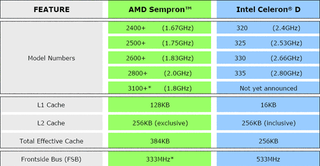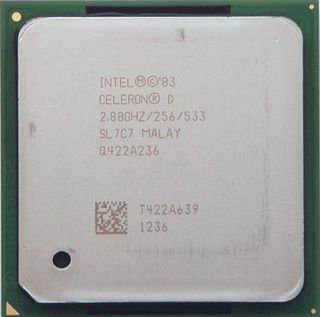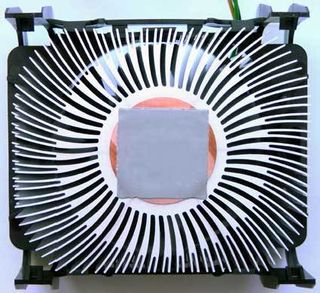Duron Successor: AMD Sempron
The Competitor: Intel Celeron D

While the Celeron for Socket 478 has been based on the Willamette (up to 1.8 GHz only) and Northwood cores, the Celeron for Socket 775 will only be based on the Prescott in order to provide 256 kB rather than 128 kB L2 cache. This has already been released for Socket 478 and carries the name 'Celeron D'. All Socket 775 versions will be given the suffix "J", as all of them will feature the execute disable bit and Thermal Monitoring 2.
The Intel roadmap provides for Celeron D 340J, 345J and 350J models with up to 3.20 GHz in Q1/2005, and you don't need to be a genius to realize that Socket A processors based on Thoroughbred-B will certainly be outperformed by then. Particularly because AMD has no intentions of releasing faster Socket A models. In addition, the J Celerons feature the virus-protecting execute disable bit that corresponds to AMD's no execute bit.

Intel's Celeron D is available both as boxed version or tray shipped.

This one looks familiar: The Celeron D 335 currently is the top model in Intel's value line and runs at 2.8 GHz and FSB533.

I was quite surprised to see Intel bundle the Celerons with this high-grade cooler. Due to the amount of fins (they even split up in order to increase the surface) and the copper core, it works very efficiently. Unfortunately, this is also necessary, as the Prescott Celeron runs much hotter than its Northwood counterpart.

CPU-Z perfectly recognized what we were running: Intel Celeron D 335 at 1.4 V and 2.8 GHz.
Stay on the Cutting Edge
Join the experts who read Tom's Hardware for the inside track on enthusiast PC tech news — and have for over 25 years. We'll send breaking news and in-depth reviews of CPUs, GPUs, AI, maker hardware and more straight to your inbox.
Current page: The Competitor: Intel Celeron D
Prev Page AthlonXP To Be Phased Out Next Page Sempron 3100+ Is A Familiar FaceMost Popular

